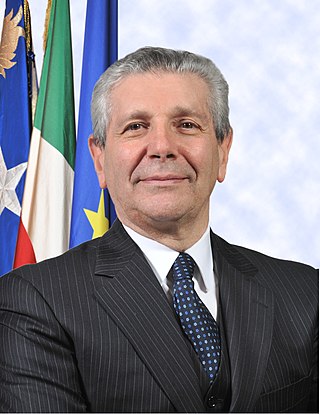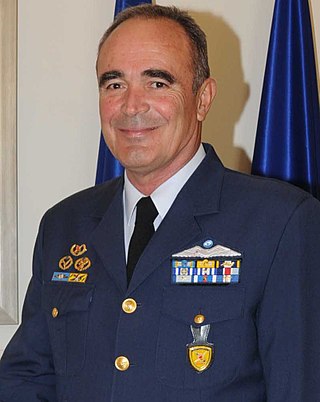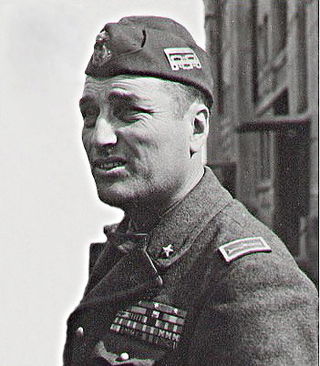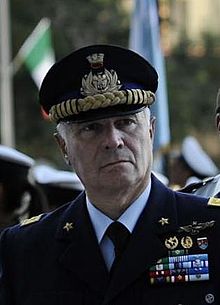
The Italian Armed Forces encompass the Italian Army, the Italian Navy and the Italian Air Force. A fourth branch of the armed forces, known as the Carabinieri, take on the role as the nation's military police and are also involved in missions and operations abroad as a combat force. Despite not being a branch of the armed forces, the Guardia di Finanza has military status and is organized along military lines. These five forces comprise a total of 340,885 men and women with the official status of active military personnel, of which 167,057 are in the Army, Navy and Air Force. The President of the Italian Republic heads the armed forces as the President of the High Council of Defence established by article 87 of the Constitution of Italy. According to article 78, the Parliament has the authority to declare a state of war and vest the powers to lead the war in the Government.

Giampaolo Di Paola is an Italian naval officer who served in the government of Italy as minister of defense from November 2011 to April 2013. He was the Italian military's Chief of Staff from 10 March 2004 to 8 February 2008 and served as Chairman of the NATO Military Committee from 2008 to 2011.

The 17th Raiders Wing is the Italian Air Force special forces unit. It is the youngest special force created in Italy. It is based in Furbara, near Rome and part of the Comando interforze per le Operazioni delle Forze Speciali. Until 8 April 2008 the unit was named Reparto Incursori Aeronautica Militare but with the expansion and evolution of the unit's assignments and its size, the name was changed to "17° Stormo Incursori".

Alessandro Guidoni served as a general in the Regia Aeronautica. Guidonia Montecelio, the small town and comune where he died while testing a new parachute, was named after him in 1937.

Air Chief Marshal Ioannis Giangos is a retired Greek Air Force officer and a former Chief of the National Defense General Staff of Greece. He served as an interim Minister for National Defence in the Caretaker Cabinet of Vassiliki Thanou-Christophilou.

Jean-Paul Paloméros is a retired general of the French Air Force and served as Supreme Allied Commander Transformation, a senior military post in NATO. Paloméros previously served as Chief of Staff of the French Air Force from 2009 to 2012.

Général d'armée aérienne Denis Mercier is a former Chief of Staff of the French Air Force. He was appointed on 17 September 2012. On September 30, 2015, he succeeded General Paloméros and became Supreme Allied Commander Transformation of NATO.

Operational Land Forces Command is the Italian Army's major command tasked with the operational and administrative control of most of its combat forces. COMFOTER reports directly to the Chief of Staff of the Italian Army. The command is based in Rome.

Air Squadron General Enzo Vecciarelli is an Italian Air Force officer, former Chief of the Defence Staff of the Italian Armed Forces. He previously served as the Chief of Staff of the Italian Air Force before being appointed Chief of the Defence Staff.

Admiral Giuseppe Cavo Dragone is an Italian naval officer, currently serving as Chief of the Defense Staff since 19 October 2021. Prior to his assumption, he served as the Chief of Staff of the Italian Navy from 21 June 2019 to 19 October 2021, and as commander of the Joint Operations Command, and the Joint Special Forces Operations Headquarters.
The article provides an overview of the entire chain of command and organization of the Italian Air Force as of 1 January 2018 and includes all currently active units. The Armed Forces of Italy are under the command of the Italian Supreme Defense Council, presided over by the President of the Italian Republic. The Italian Air Force is commanded by the Chief of the Air Force General Staff or "Capo di Stato Maggiore dell’Aeronautica Militare" in Rome.
The following is the structure of the Italian Navy as of June 2020. It is considered a multiregional and a blue-water navy.
Leonardo Tricarico is a former Italian Air Force general. He served as Chief of Staff of the Italian Air Force from 5 August 2004 to 19 September 2006. Vincenzo Camporini was appointed as his successor.
The Joint Operations Headquarters is the Italian joint operational command directly reporting to the Chief of the Defence Staff. This command exercises the planning, coordination and direction of the military operations of the Italian armed forces, and on joint and multinational exercises and all activities connected to them. Through the COVI, the Chief of the Defence Staff is able to exercise his functions as Operational Commander of the Armed Forces.

Pietro Pinna Parpaglia was a general in the Royal Italian Air Force during World War II, Deputy Chief of Staff of the Regia Aeronautica from 1933 to 1939 and commander-in-chief of the Air Force in Italian East Africa from 1939 to 1941.

Mario Ajmone Cat was an Italian Air Force general during World War II. He was Chief of Staff of the Italian Air Force from 1944 to 1951.

Pietro Piacentini was an Italian Air Force general during World War II, minister of the air force and Chief of Staff of the Italian Air Force from 19 June to 12 December 1944.

Mario Bernasconi was an Italian Air Force general during World War II. He commanded the Reparto Speciale Alta Velocità during the interwar period, the Aviazione Legionaria during the Spanish Civil War, and the 5th Air Fleet in North Africa during World War II.

Enrico Pezzi was an Italian Air Force general during World War II. The youngest general in the Regia Aeronautica, he is best known for leading the Italian Air Force in Russia, where he was killed during a rescue mission in late 1942, being posthumously awarded the Gold Medal of Military Valor. He was the brother of Mario Pezzi, also a general in the Regia Aeronautica.

Fernando Silvestri was an Italian Air Force general during World War II.

















